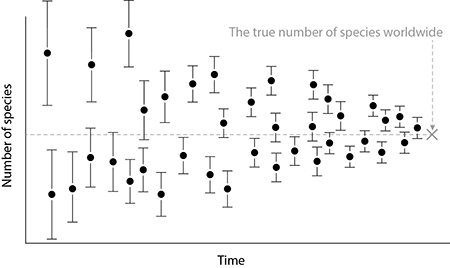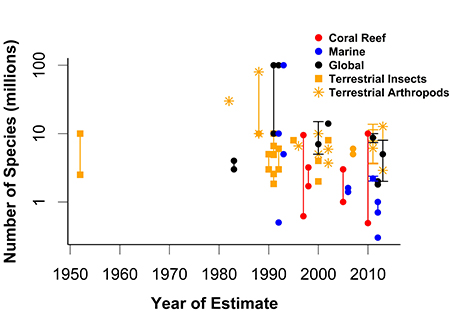How many species are on Earth?
Answering this simple question is not easy, but essential if we are to understand impacts of global change and manage environmental resources successfully. Without baseline knowledge of how many we have or what we have in different places, how do we know what we have lost, or might lose and how do we manage these natural resources to minimise extinctions?
Investigating biodiversity through searching, collecting and identifying new species is a slow process and does not provide a definitive answer about how many species there are until the job is complete. For example, in the most comprehensive survey of global marine life, the Census of Marine Life (to which AIMS contributed to the CReefs project) took over a decade, 540 expeditions, 2 400 scientists and USD650 million. Even at the end of such a large-scale project, scientists are left marvelling at the number of species still left undescribed.
To fill in this knowledge gap about global species richness, scientists use current knowledge of species richness to predict the total number worldwide. With no true value to verify these global estimates, the accuracy of such estimates is difficult to assess. However, as many estimates are pooled and compared over time, evidence can emerge that indicates whether or not estimates of species richness are becoming more precise and/or accurate. If so, the level of uncertainty surrounding the estimates would reduce and the estimates themselves would converge – that is, there should be evidence that estimates are heading towards the same total (see below graph).
Julian Caley from the Australian Institute of Marine Science and co-authors recently assessed the history of estimates of global species richness using these criteria. They compared biodiversity estimates from a range of taxa, ecosystems and realms spanning the last 6 decades). Over this period, global species predictions range widely, from 0.5 million global species to over 10 million. Importantly, however, uncertainty surrounding these estimates has not reduced over time, and the estimates are not converging, as demonstrated in the graph below.
In addition, many of the estimates are completely at odds with one another. For example the number of species in our oceans cannot be greater than the number for the entire planet, and the number on coral reefs cannot be greater than in all the oceans combined, yet these sorts of logical inconsistencies are common among these estimates.
Biodiversity researchers from around the world, including AIMS staff, are involved in series of workshops to try and resolve these issues surrounding global species richness estimates. It is clear that new approaches are required to better understand Earth’s biodiversity and its trends. Caley and his co-authors suggest that as well as ensuring future estimates include levels of uncertainty and are improved upon, adaptive learning methods could speed up convergence of estimates. Adaptive learning would consider previous biodiversity estimates and methods in new predictions. These improvements, along with continued species discovery and identification, should see uncertainty diminish and estimates converge on the essential, yet currently elusive, number of species on Earth.




